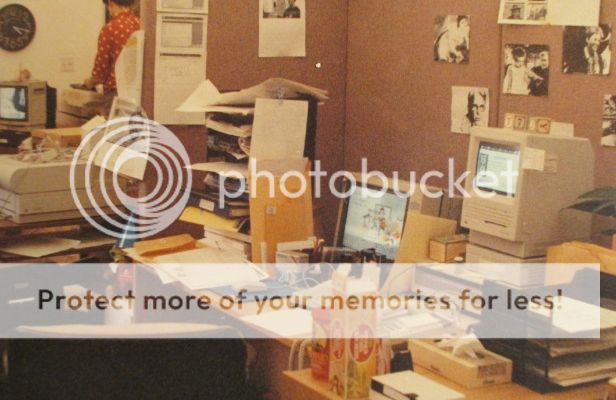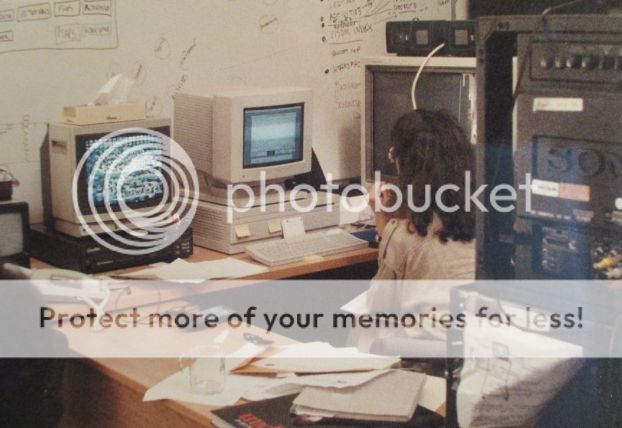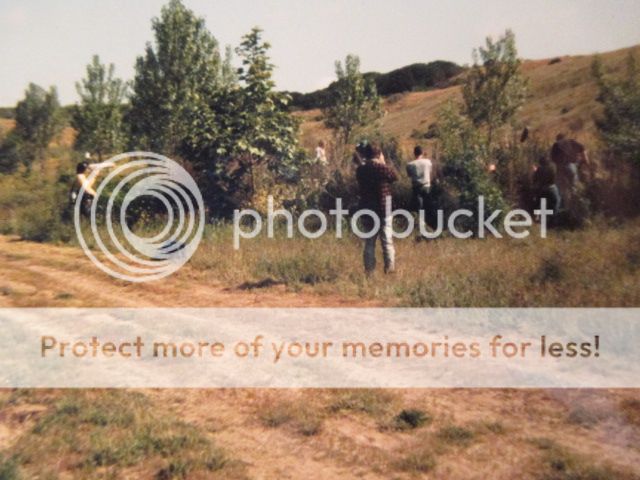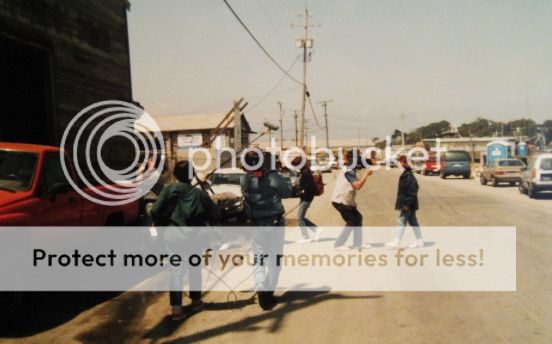Working For Apple
The first time I visited the Santa Clara Valley was in 1966 for that football game (see Football & Cotillion). The second time I visited the, now, Silicon Valley was in 1987. I had recently co-authored a couple technical books on Apple’s HyperCard software program and the HyperTalk computer language (see Programming & Tech Writing) and was traveling to Los Gatos to talk to some people about other book/programming projects. I was living in San Francisco so I rented a car and drove down I-280, for the first time, to Cupertino. There was no need for me to stop here but I felt I couldn’t drive by without at least taking a peek at the Apple campus. I had a hard time finding it but finally I pulled up outside Mariani 1 -- the corporate address on the documentation that came with my original Macintosh computer. I felt like a pilgrim at a holy shrine.
Within a year I was working for Apple in San Francisco at the Apple Multimedia Lab and two years later I was commuting to Cupertino either down I-280 or on the train and working around the corner in the building known as Valley Green 6. Over the years I worked in seven different Apple buildings, including Mariani 1, while working on educational software, software testing, language documentation, and help systems.
The Apple Multimedia Lab - 1989
Through BMUG and the books, I started meeting people deeper into the Macintosh and HyperCard communities. I got a job as a HyperTalk programmer at Apple’s Multimedia Lab in San Francisco turning the ideas of a bunch of MIT brainstormers into programs that actually worked.
The main project we were working on at the Lab was The Visual Almanac. Here's a video:
I still have friends from the Lab and it always surprises me when they bitch about working there because it was my favorite job. The work was interesting (though of questionable value) and the people were great while the money was sweet. Maybe the thing I liked best was how the work drew on so many of my areas of expertise. The content of the Visual Almanac was intended to be broad but the notes we obtained (particularly with the Bettman Archive images) were often wrong or misleading I was a font of arcane information... it was really fun for me. Where today you would just Google something, back then they would ask me.
My workstation at the Lab. (The crackers belonged to Mary.)
J5 using then state-of-the-art computer and video equipment. The monitor on the left is sitting on top of a laserdisc player controlled by the Mac 2.
Moss Landing
Toward the end of my time at Apple’s Multimedia Lab, the Lab plus a bunch of audio/video people teamed up to document the area around Moss Landing, California -- midway down the coast of Monterey Bay. We rented a bunch of beach houses at Pajaro Dunes for a long weekend where we all lived and worked as we pulled off this complex but short term project. I was so busy before and during this time that I didn’t realize until years later that Pajaro was just a long walk down the beach from Sunset State Park where I had camped the summer of 1970 (see On the Road - Monterey).
This weekend was all about collecting “content” so there was no programming to do, consequently I was enlisted as a roadie for one of the videographers. I carried around heavy cameras, tripods, light reflectors, batteries, and the like. It was a lovely change of pace for me. I also was given a camera and asked to document the documenters.
In addition to capturing a photographic record of the place, similar to what Google StreetView does today, we also followed around locals documenting them, including their observations on the place and their intersections with each other.
We photographed and videotaped everything that moved from the ground, from a helicopter, kayaks, and other boats. We documented the seal in the slough, the oysters from oyster bed to seafood shop to their disappearing down the gullet of some of the videographers. It was one of the most fun things we did at the lab.
Here a half dozen video and sound people document a small pond near Moss Landing. (We had extremely sensitive underwater microphones that could record all the sounds made by the pond denizens.)
In addition to capturing a photographic record of the place, similar to what Google StreetView does today, we also followed around locals documenting them, including their observations on the place and their intersections with each other.
Here I document my team documenting Fabrice documenting a local school girl.
We photographed and videotaped everything that moved from the ground, from a helicopter, kayaks, and other boats. We documented the seal in the slough, the oysters from oyster bed to seafood shop to their disappearing down the gullet of some of the videographers. It was one of the most fun things we did at the lab.
Apple Vivarium Project
After the Lab, I did a quick job in the derivative (but with color) SuperTalk language for Alan Kay’s Vivarium Project in Beverly Hills. Again this was using the computer to control the display of video content on a laserdisc. (They put me up in a B&B off Wilshire for a week while I ate very well and slept hardly at all as I rushed to finished their project.)
Iduna
I was supposed to start a job for the National Geographic and Lucas Arts at Skywalker Ranch in 1989 but the project got delayed, so I took a job working as a tester for Apple in Cupertino on HyperCard IIGS (code named Iduna, I still have the t-shirt) -- a version of HyperCard for the Apple IIGS computer (which was still popular in schools in 1990). This was the only color version of HyperCard Apple would ever ship.
This was an extended job and I had to commute all the way down to Cupertino either by train or carpool. That sounds simple enough, but there were also two buses on the SF end to get to the train station and one on the Sunnyvale end to take me to Cupertino. I was spending about six hours a day in transit. Carpooling was much faster, one LRV to get to the car (which I drove) and a long drive to the Apple campus where the woman who owned the car, but who was still learning to drive, and I worked in different buildings. But then my group got moved to another Apple building in Santa Clara and I was back to the train again. Working for Apple like this I got spoiled by having multiple computers on my desk -- this was also the first time I worked in cubicles. Having multiple computers is a wonderful thing when you are doing software development or, as in this case, testing. All the buggy, Alpha and Beta software can be isolated on one machine while you do everything else on a relatively stable machine. After this, I would always try to have multiple machines for development, often one Mac and one PC.
Working for Apple in Silicon Valley was even nicer (aside from the commute) than working at the Multimedia Lab had been. Every Friday afternoon there was a Beer Bust with free food and drinks. This sounds frivolous but, aside from resulting in the infamous “Friday Code”, it really paid off. Everyone would gather around the food and drink and, since we were all nerds, we would be talking about our work problems. People would make suggestions or the beer and wine would inspire us to rush back to our cubicles and hammer out some brilliant code. On Monday morning, the code would turn out to be rather flawed, but the idea would often hold up. Valley Green 6 was the first Apple building I worked in but it didn’t have it’s own cafeteria so we would troop over to Mariani 1 for lunch every day -- this was the same building I had sought like a shrine the first time I drove down to the Valley back in 1987.
HyperCard 2
During the ‘90s, Apple spun off its software production to a new company called Claris. These were bleak days when the lack of the guiding hand of Steve Jobs was most painfully obvious. Claris started development of a color version of HyperCard, to be called HyperCard 2, and I was brought in as a contractor to write the documentation. Aside from the programmer hired from outside to write the core code, most everyone on this team was part of the HyperCard community and many were friends of mine. Documenting HyperTalk, the language, meant that I was using it as thoroughly as any of the testers. Before I could tell other people how it worked, I had to learn it completely myself, and this lead to my finding problems and making suggestions. It was going to be a great language and I was right in the middle of it... I even got to go along on the tequila-fueled off-site at Silverado Country Club.Unfortunately, the outsider who had spent years writing the core code, had, at the very beginning, not really understood the whole HyperCard metaphor and it turned out that what he had created wasn’t capable of giving the performance we needed. Claris decided it wasn’t worth starting all over again, and killed the project. On my shelf at home is the draft of what was to be the documentation for HyperTalk 2. It would have been the best book I had authored (we had a great artist working on the illustrations) but that was not to be.
Sand Painting
There were also software projects where I was the programmer that were killed before the end or never distributed for one reason or another. Because of all this, I came up with the Tibetan Sand Painting theory of software development. Tibetan monks will spend weeks carefully creating a very elaborate sand painting. When they are done, a Lama will view it to evaluate their work and then sweep the sand back into a big bag which is then disposed of in some spiritually meaningful way. The point of creating a sand painting is the process, not the end result. As a programmer (or tech writer) I knew I only had control over the quality of my own work. What became of the project was out of my hands and not something worth worrying about. Of course this is easier said than done.
B&B
Shortly after my first pilgrimage to the Apple campus in Cupertino, when I was just starting to socialize with my HyperCard friends in the still mysterious (to me) South Bay, I was dropped off and abandoned one night at the home of some friends of friends who were then getting ready to ship an early HyperCard product for children. I stayed to help them prepare the product for shipping (I recall there was shrink wrapping involved) and ended up sleeping on their sofa. I worked with both of them on Iduna and with G__ on HyperCard 2. For years I consulted with them on jobs for Apple (we made system "Guides" for a variety of products). We spent many a late night in a variety of Apple buildings including good old Mariani 1. Eventually, Apple got smart and hired K__ as a manager -- a job she finally quit this spring. We are still in touch, 25 years later.They helped me move twice and I helped them move three times. But on that first evening I didn’t know who they were or where I was. I can’t account for the pleasure I take in being lost. Maybe it’s because I’m usually so analytical -- I love maps and knowing where things are -- but there is an odd thrill in being “off the map.” Soon I would be able to navigate the South Bay, though I’ve never learned it the way I know SF. Today I have favorite places around the Santa Clara (Silicon) Valley and even favorite places that still exist only in shared memories.




0 Comments:
Post a Comment
Subscribe to Post Comments [Atom]
<< Home